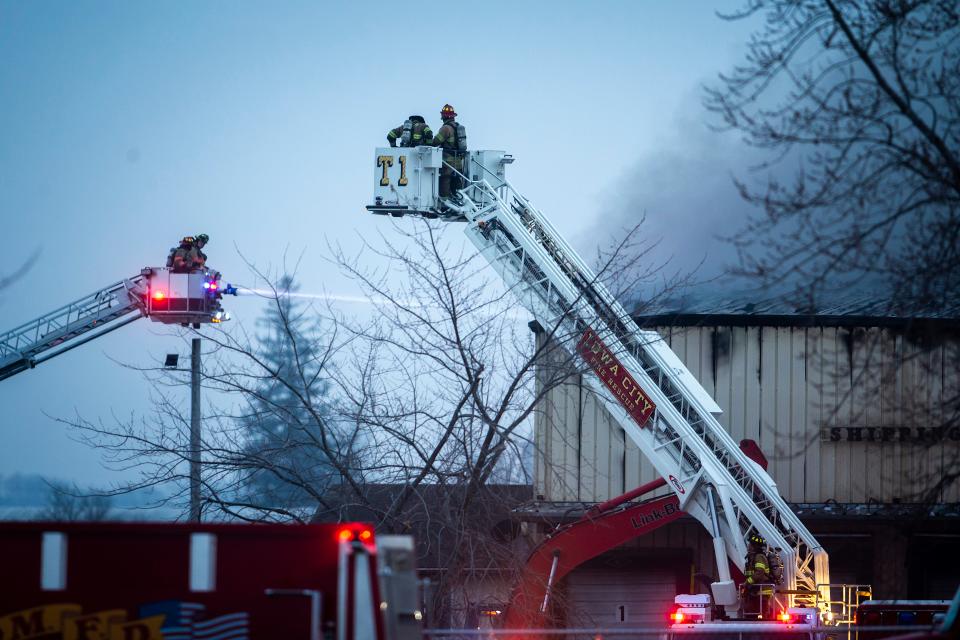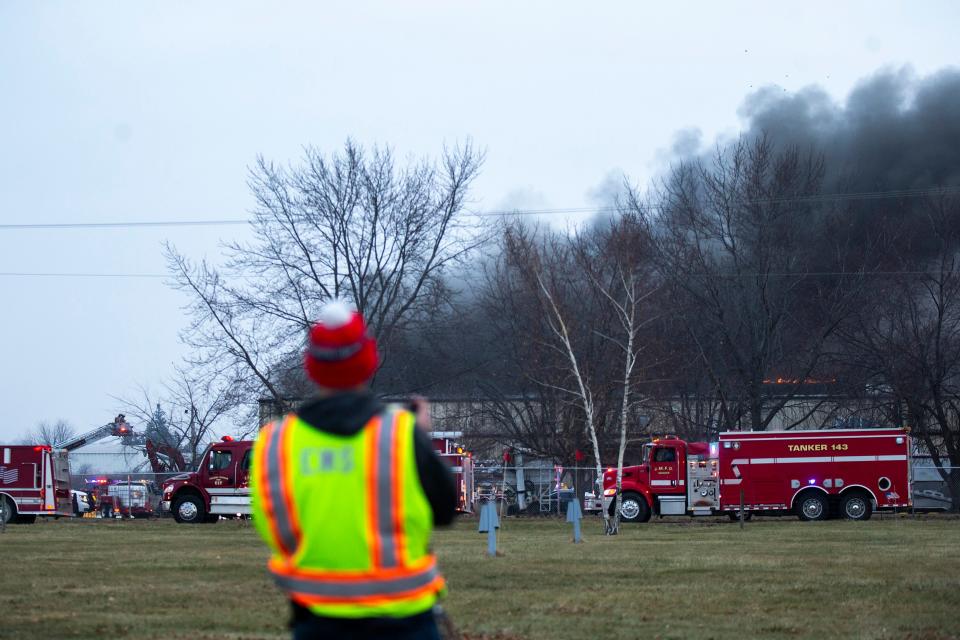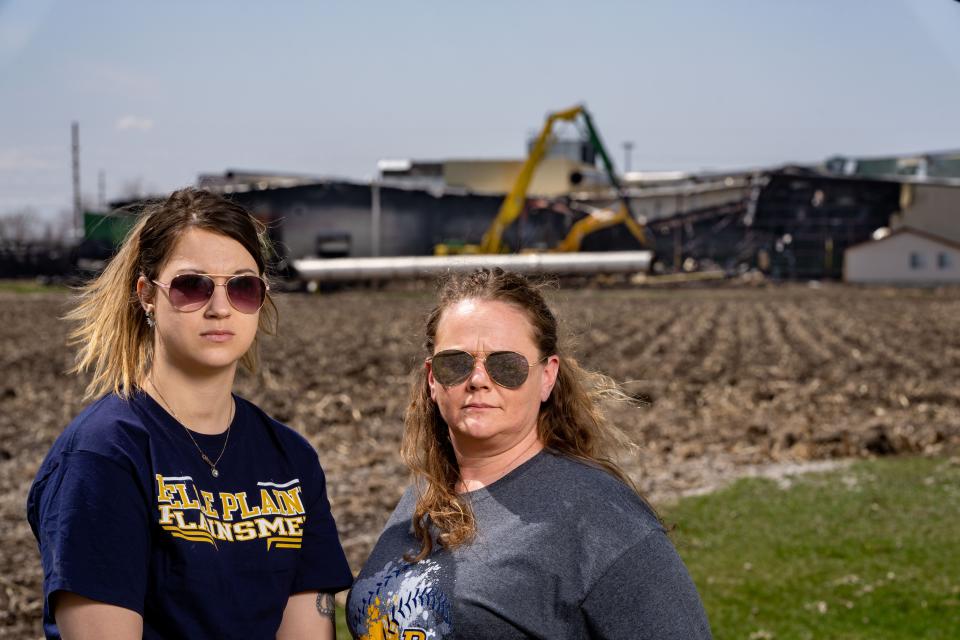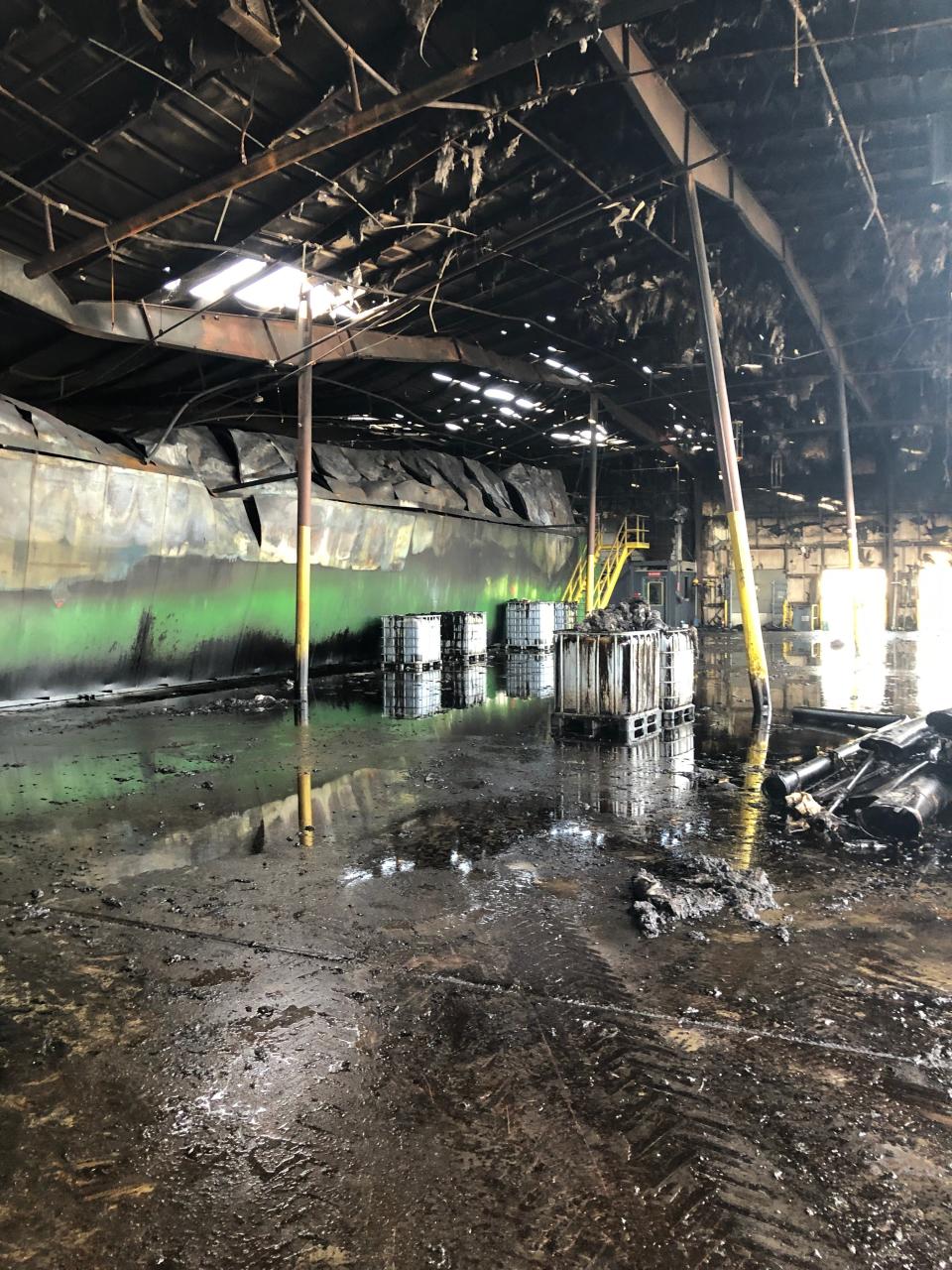Iowa factory, site of explosion, massive fire, was full of safety hazards, EPA finds
A Marengo factory that recycled asphalt shingles relied on equipment that wasn't up to electrical code requirements before a December explosion and massive fire that severely injured workers and forced evacuations, U.S. Environmental Protection officials found.
According to a report newly released to the Des Moines Register, EPA inspectors concluded after an April 27 tour of the blown-up C6-Zero plant that some equipment and electrical mechanisms in the factory didn’t meet National Fire Protection Association requirements.
The EPA has not issued a fine or any other penalty. But, according to the report, inspectors found two deficiencies of the federal Clean Air Act’s general duty clause, which requires factory owners and operators to safely manage hazardous substances.

The EPA’s inspectors concluded that C6-Zero officials failed to design a safe factory and minimize consequences of an accidental hazardous substance release.
The inspectors identified several problems inside the factory, including an out-of-compliance breaker, exposed wires in C6-Zero’s chemical storage room and an electrical box with a label that simply read “coil bad.”
“These destructive forces could cause more of the flammable substances to be released,” the inspector’s wrote in their report.
More: Months after C6-Zero explosion, fire, ill ex-employees wonder what they were exposed to
C6-Zero founder Howard Brand moved into the former soybean crush plant in Marengo in 2020 while hawking a chemical process that he claimed would dissolve used roofing shingles into their component parts: fiberglass, gravel and oil. Brand planned to sell the recycled byproducts while also receiving payment from roofers looking for a place to discard old shingles.
Employees began to operate the factory last fall. While Brand led investors on a tour of the building last December, multiple employees have told the Des Moines Register, a worker tried to unjam a clogged conveyor belt with a metal rod. Employees said the machine sparked, igniting an explosion that badly burned two employees, sent more than a dozen people to the hospital and set off a fire that it took dozens of firefighters 18 hours to extinguish.
While they battled the blaze, neighborhoods near the plant were evacuated, and testing later showed groundwater contaminated with toxic substances including benzene, a virulent carcinogen.
More: 'Vomiting on a daily basis': What workers say it was like inside C6-Zero before the explosion
More: C6-Zero denies significant use of carcinogen benzene before Marengo plant explosion, fire
Asked about the EPA’s inspection report Wednesday, C6-Zero spokesperson Mark Corallo said in an email, “The report from April is part of the ongoing effort to conclude all matters related to the C6-Zero fire in Marengo, and the company continues to work with EPA on final cleanup and other matters.”
EPA spokesperson Kellen Ashford, meanwhile, declined to say whether the inspectors’ findings will lead to a fine.
“EPA is evaluating compliance and does not discuss the details of potential enforcement actions,” he said.

Reviewing the EPA document, University of Iowa environmental law professor Shannon Roesler said in an email that the document does not appear to be the last version of whatever report the inspectors will ultimately produce.
“This is just a step toward a finalized report that could support a sanction,” she said.
Any punishment from the EPA would be just one of many legal challenges facing Brand and C6-Zero. The agency also told company officials in April that they violated a federal law by failing to give local firefights information about their chemicals before the explosion.
On Sept. 16, a judge ordered the company to pay a $96,000 Iowa Occupational Health and Safety Administration fine after the state labor department sued, claiming company officials failed to follow through on a settlement involving 11 workplace safety violations.
More: C6-Zero agrees to $95,000 OSHA fine for safety violations tied to Marengo factory explosion
The Attorney General’s Office, meanwhile, has sued the company for repayment of $892,000 that Gov. Kim Reynolds tapped to clean up and remove 13 million gallons of water in a basin next to the exploded factory.
Six employees also have sued the company. A former maintenance worker, Kelly Regenold, alleged in a March lawsuit that he suffered severe burns to about one-third of his body, leading to “extensive” scars and disfigurement. Other employees have claimed in lawsuits that they suffer from back pain, hearing impairment, post-traumatic stress disorder, headaches and nosebleeds “that wouldn’t stop.”

Corallo, the company spokesperson, told the Register in an email, “C6-Zero will fully comply with the court.”
EPA: Marengo factory not set up to protect workers from emergencies
C6-Zero planned to turn shingles into fiberglass, gravel and oil by running the material through a series of rotating trommels, or mesh drums, with a conveyor belt connecting each machine. The company would load the trommels with chemicals ― most notably a solvent the company called Kaniksu that would melt the shingles.
Employees said company officials declined to tell them what was in Kaniksu, a violation of OSHA standards. According to a safety data sheet for the substance, though, the mix can scar lungs corrode eyes and severely burn skin.
More: How do you get rid of 85K gallons of tainted water, 15M pounds of soil from C6-Zero site?
Kaniksu also is a flammable liquid and an oxidizer, meaning it spontaneously ignites when it mixes with a combustible material. Kaniksu also can increases other chemicals' burn rate.
According to an August 2022 report from SAFEX, a contractor that reviewed the company’s process, most of C6-Zero’s factory would have needed to comply with the National Fire Protection Agency’s Class 1, Division 2 standard. This is a designation for areas of a factory where flammable gasses and vapors are only present during “abnormal” conditions.
More: Iowa plant that exploded won't join National Priorities list, EPA says
EPA inspectors concluded during their April tour that several pieces of C6-Zero equipment didn’t meet this standard, including a noncompliant breaker, exposed wires and an electrical box that someone labeled “coil bad.”
Other out-of-compliance equipment included lights, a lamp and a pulley mechanism inside a conveyor. Inspectors also noted the electrical system joint box in the chemical storage room had holes known as “knockouts,” a design that isn’t compliant with the required safety standards. On other pieces of equipment, the inspectors found data plates that they couldn’t read, leaving them unable to evaluate the machines.

In addition to the equipment problems, the inspectors said the factory was not laid out to properly protect workers. They said the shower station and eyewash bowl for chemical exposure was “multiple doorways” from C6-Zero’s chemical storage room.
More: Marengo plant that exploded sought to turn shingles into 1,800 barrels of oil daily
“It is unlikely the emergency equipment would be effective in reducing consequences to an individual contaminated with hazardous substances given the distance the individual would need to navigate in an emergency,” the inspectors wrote.
Marc McClure, an Osage-based safety consultant who reviewed the EPA document for the Register, said the investigators’ report shows that C6-Zero officials set up the factory incompetently.
“The equipment was never going to function safely because it wasn’t designed to function safely,” he said.
Tyler Jett is an investigative reporter for the Des Moines Register. Reach him at tjett@registermedia.com, 515-284-8215, or on Twitter at @LetsJett. He also accepts encrypted messages at tjett@proton.me.
This article originally appeared on Des Moines Register: C6-Zero plant operated unsafely before explosion, fire, EPA finds
